The Whip and the Body (1963)
Directed by: Mario Bava
Written by: Ernesto Gastaldi, Luciano Martino, Ugo Guerra
Starring: Christopher Lee, Daliah Lavi, Evelyn Stuart, Tony Kendall
AKA LA FRUSTA IL CORPO, NIGHT IS THE PHANTOM, WHAT?, THE WHIP AND THE FLESH
ITALY
AVAILABLE ON BLU-RAY AND DVD
RUNNING TIME: 86 min
REVIEWED BY: Dr Lenera, Official HCF Critic
Debauched aristocrat Kurt Menliff returns to his ancestral home in the hopes of taking over the estate from his ailing father. The maid Giorgia is anxious to get back at him because he caused the suicide of her daughter Tania when he walked out on her and, due to his father’s hostility to him, he finds that that his brother, Christian, is now next in line. Christian is now married to Nevenka, with whom Kurt used to have a sado-masochistic relationship. Although initially hostile to the return of her lover, she can’t resist her impulses and lets Kurt seduce on the beach. Then someone kills Kurt, but is he really dead?…..
In 1967, snobby critics fell over themselves in praising Belle De Jour for its boldness, its insight and its artistry. Four years before, Mario Bava also made a film about a woman increasingly dominated by her sado-masochistic leanings, and of course it was largely ignored. Admittedly it was heavily cut in many countries for cinema release, the British version losing a whopping thirteen minutes to remove every single reference to sado-masochism which must have made the story almost incomprehensible, and it was also a horror film, a genre generally looked down upon back then. But I will go on record as saying that I believe it to be the better film. Insanely romantic, unashamedly perverse, psychologically complex and visually ravishing, The Whip And The Body to me ranks only behind his masterpiece Lisa And The Devil in Bava’s filmography and might be a better representation of his art, a better example to show people what this genius, largely unsung in his day and still fairly “fringe”, was about, what he could achieve with very little money at his disposal. It’s an absolutely stunning exercise in the Gothic, mixing ghost story, love story, murder mystery and psychological drama to incredible effect, and it does it with, aside from one funeral scene, a cast of just seven people. Despite me certainly not being alone in loving the film today and recognising it as something of true worth, it still isn’t too well known, despite having some seemingly salacious content which you’d think would make it quite famous.
Ernesto Gastaldi was asked to write something like The Pit And The Pendulum, which had been a big success in Italy and had already inspired a few films. The Knife In The Body and Spectral were the titles of the first and second script drafts. Lee actually turned the role of Kurt down, then reconsidered when Bava, whom he’d worked well with on Hercules In The Haunted World two years before, came on board. Bava wanted to cast his Black Sabbath star Barbara Steele as Nevenka, and she would have been magnificent, but she turned the role down claiming she was being typecast in horror films – though this didn’t stop her appearing in a few more not long after. Shot in a studio in Rome and Tor Caldara, that beach we often see in Bava’s movies, the film ran into trouble even before release with the distributors insisting that the credits be altered so it would seem to not be an Italian production, Bava becoming ‘John M. Old’, though this didn’t stop one enraged male viewer in Rome from suing Titanus Production for offending him so much. This didn’t go to court, but the film was then seized anyway with charges of obscenity, it containing “several sequences that refer to degenerations and anomalies of sexual life.” After some fuss it was allowed to be released again, but with cuts and in very few cinemas. Bava’s usual American distributors IP turned it down outright, though three years later Thunderbird Films gave it a small release there under the title What? Sources differ as to whether it was cut or not. Not a commercial success anywhere, the film slipped into virtual obscurity, rarely seen except in the odd mutilated TV version, until its DVD release. I should say right here that if you decide to watch or buy this movie, don’t watch the English language print. It virtually gives away the main twist early on by adding a line to one scene. God knows why this was thought to be a good idea.
Now The Whip And The Body moves very slowly for its first half, its stately pace even more leisurely than that of the Corman/Poe films it’s clearly influenced by, and with even more scenes of characters walking slowly down passage ways, but it immediately sets a morbid, decadent and powerfully claustrophobic atmosphere with the housekeeeper Giorgia looking at the encased sword which her daughter used to kill herself. The setting is ambiguous, partly because it allowed freer re-use of older props. After a terrific shot of Kurt riding on his horse along the beach to the Castle Menliff which is the same photograph glued to a sheet of glass that was in Eric The Conqueror, the scene of Kurt returning to his family who really don’t want him there at all, I immediately think of Wuthering Heights, and the film can almost be seen as a twisted variant on that oft-told [though rarely faithfully] tale, but I mention this primarily because Lee would have been such a good Heathcliff. Until Lisa And The Devil, the film is also Bava’s ultimate exploration of his favourite theme of family destruction from the inside, this lot really existing in a tangled web of virtually incestuous intrigue. Kurt and Nevenka are both cousins, but Nevenka is locked in a relationship with Kurt’s brother, who is actually in love with Nevenka’s sister. It’s even subtly suggested that Nevenka is involved with her father-in-law. Bava and his screenwriters treat these corrupt characters with a bit of sympathy and certainly don’t judge them. In fact, the moral element that’s present in many Bava pictures isn’t really in this one, though this one continues Black Sunday‘s idea of decaying aristocracy [and there’s another secret passage behind a fire place too].
Now, I’m going to honest with you here, the main reason I decided to re-visit this particular Bava film, aside from the fact that I’m often breaking my promise of doing a Bava review a month and needed to do one, is that lousy Fifty Shades Of Grey film making me to want to see a ‘good’ picture that has vaguely similar subject matter. The Whip And The Body is partly about two old lovers who rekindle their sado-masochistic relationship, and they have their first proper ‘reunion’ on a beach. Nevenka strikes Kurt across the face with his riding crop, but he calmly takes it out of her hand, pushes her to the ground and whips her while her subdued reactions begin to show sexual excitement in a scene which has a stronger erotic charge, while still being disturbing, than anything in the 2015 film. A later scene has Nevenka biting her fingers as she gets more and more aroused by Kurt coming to her even before he’s whipped her, a very daring but perfectly pitches thing for an actress to play in 1963. All this is set to music of the most passionately romantic manner, extremely melodramatic in a way that you don’t really see or hear today. Soon somebody kills Kurt, and I should say right here that, if you decide to watch or buy this movie, the English language version provides an aural clue to later events which the Italian one doesn’t. God knows why this was thought to be a good idea, though admittedly some may not properly pick up on it. Anyway, somebody kills Kurt, but it seems that he won’t stay dead, and here is where the film is at its most brilliant.
Nevenka plays the music theme on her piano which seems to summon Kurt back from the grave, and we’re treated to a stunning build up of tension and horror, yet given a twist in that Nevenka is both frightened by and desires this spirit. As Bava’s incredible lighting schemes go into overdrive, normally harmless things such as mud on the floor, a branch hitting a window like Kurt’s whip, even a door handle that resembles said riding crop, create a tremendous feeling of fear. Kurt is first glimpsed standing outside Nevenka’s window in a shot maybe cribbed from The Innocents. Of course nobody believes Nevenka that Kurt is back, and evidence of his presence is gone by the morning. Is the extreme closeup pan that slowly moves along Nevenka’s hair, the darkness of both said hair and the room enveloping the screen before we see her eyes and a tiny portion of the surrounding area being lit up one of the greatest visual representations of screen horror ever, a shot that gets to the very essence of why we love being scared so much? Eventually, on the third night, Kurt appears in silhouette in Nevenka’s room, and Nevenka shuts her eyes, but when she opens them a horrible huge hand reaches out from the dark, in an especially frightening moment. After Nevenka is brutally whipped, Bava could not, of course, show the couple actually having sex, so he tries a more expressionistic approach that is incredibly effective. When Kurt goes to kiss her, his face, advancing right towards the camera, is bathed in intense blue, than green, than finally red as it seems to hit the camera and then evaporate. How haunting, and how magnificent was the genius that is Bava, endlessly dreaming up ways to depict things despite having so little to work with, and creating great art as he does!
Does the film dip a little after the reunion of its main pair of lovers? I would admit that it does, with one particular event, another body that crops up, not being done with the dramatic emphasis it perhaps could have done, but the powerful atmosphere remains and the build up to the final revelations is very well done in terms of storytelling. The script, which had Gastaldi’s work being augmented by Luciano Mantino and Ugo Guerra’s, is so strong that even a poor director with no visual flair at all would have probably made a half-decent film out of it, though it’s worth noting that Gastaldi was disappointed with the end result, feeling that Bava’s emphasiing of the visual side of things undermined the psychological elements.. Its depiction of its central relationship is especially intelligent. Kurt is a bad man and Nevenka a disturbed woman, yet the film remains non-judgemental on the two getting together. The Whip And The Body entirely avoids graphic horror except for a decomposing, burning body which looks disturbingly convincing, as it moves to its conclusion. The mystery is solved up to a point, but doesn’t explain everything at all and in fact ends up being rather vague. The script refuses to tell us if we’ve been watching a ghost, ghostly possession or just plain old madness, while giving us clues that it could be one or more of those. I suppose that it’s possible to see this is a flaw, a sign of laziness, but I don’t think so considering how good the writing is elsewhere as it dares to dip into waters filmmakers even today don’t tend to, like, for example, the possible link being arousal and terror, or even how close love and hate can really be. There’s a hell of a lot going on in this film. And what is with that bizarre funeral scene, vaguely Greek Orthodox but with people in red cloaks and hoods?
Right from the offset this is the most visually stunning film Bava ever made. Scene after scene – no, shot after shot- should be studied from in how to make something look great, from meticulously constructed long shots composed of different colour areas which are absolutely gorgeous to look at, to closer shots which often have two colours clashing. The primary colours are black, violet and mauve, but Kurt’s nightly visits to Nevenka are bathed in startling splashes of red, green and blue. Bava achieves so much with so little, and it’s not just style for style’s sake either; his use of colour in this film often emphasises psychological states. For a start, just look at how characters are often only partially backlit, sometimes with the backlight just at the point of being completely off, giving every cast member a sense of mystery, despair and misery. Considering all this, it’s a crying shame that all three of the current Blu-rays of this film, based as they are on the same obviously highly flawed print, are very unsatisfactory. They are considerably darker than they should be, which ruins some of Bava’s complex lighting schemes. I suppose you could say that maybe they’re closer to what Bava intended and the more colourful DVD’s are inaccurate, but considering the look of Bava’s other work, I don’t think that is true. Seeing as the streaming versions appear to be taken from the Blu-ray print, if you want to experience this treasure then one of the DVD versions is a much better bet until this film is restored properly.
Of course it all wouldn’t work so well if it wasn’t for the two central performances. Kurt in my opinion is Lee’s second greatest role [I’m sure you can guess the first!], and he’s hypnotic in the role; cruel, scary but incredibly charismatic. Sadly his voice, like everyone in the cast except for Tony Kendall, is dubbed in both the Italian and the English language prints [as usual with these films, it was shot silent], and this is a considerable shame, as hearing his distinctive voice would have doubled the effectiveness, though the guy that dubs him in the English print does attempt to sound like him. Lee, who expressed fondness for this film, was disappointed by being dubbed and thereafter tried to make sure that he dubbed himself in later Continental horrors. Daliah Lavi as Nevenka is possibly even better, in that it’s a harder and braver part. She is heartbreaking as a woman engulfed in a love that may destroy her and frightening as someone on the edge of sanity. I actually can’t think of many other actresses that could have conveyed that so well scenes where her expression has to go from terror to pain to acceptance to sexual pleasure. The way she touches her body when Kurt is near is also notable. All the other cast members are fine, and the icing on the cake is provided by Carlo Rusticelli’s music score. His gorgeous, eight-minute piece “The Windsor Concerto”, exuding yearning and passion, provides the rhapsodic material that alternates with more atmospheric pieces employing the mellotron. After I first saw this film I couldn’t get the beautiful music out of my head, and it gives the proceedings both an ironic element and the feel of a great love story, which The Whip and The Body ultimately is. Beneath its darkness, its fear and its pain is a really moving story of two people who need each other and don’t let a little thing like death stop them.

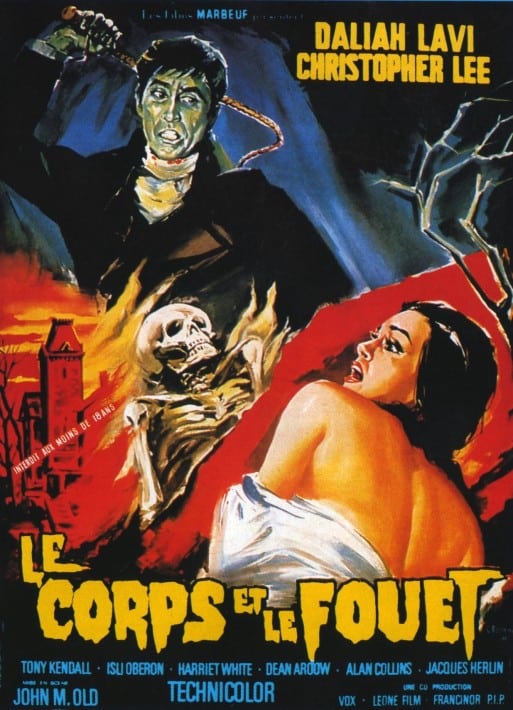
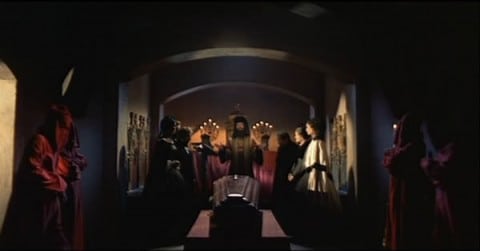
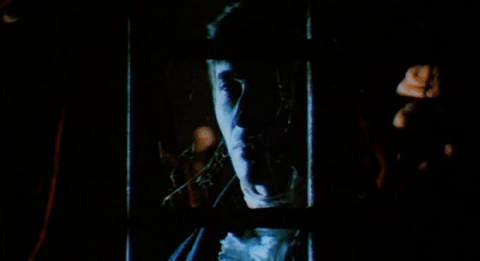
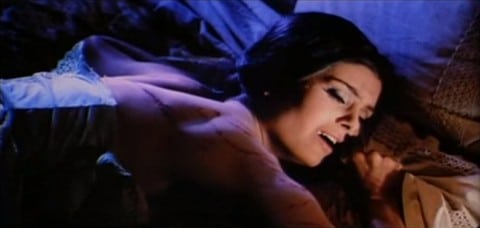



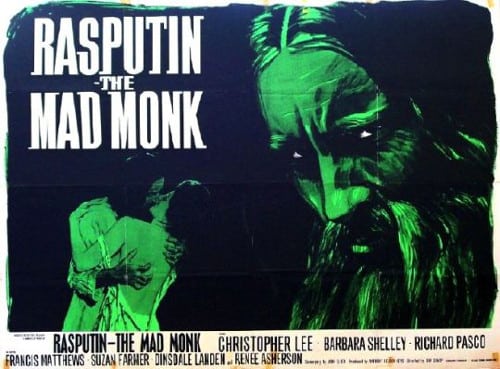
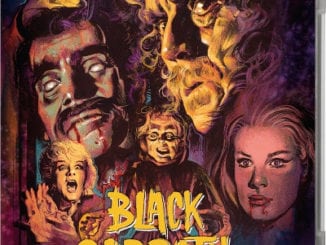
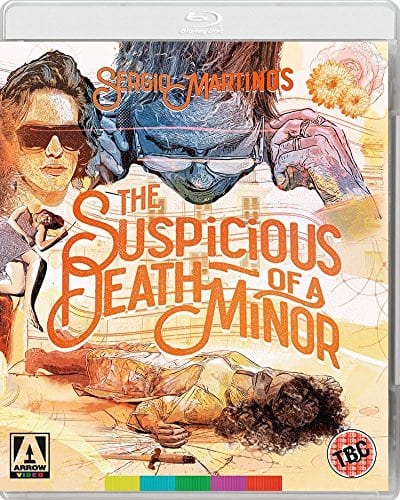
Be the first to comment